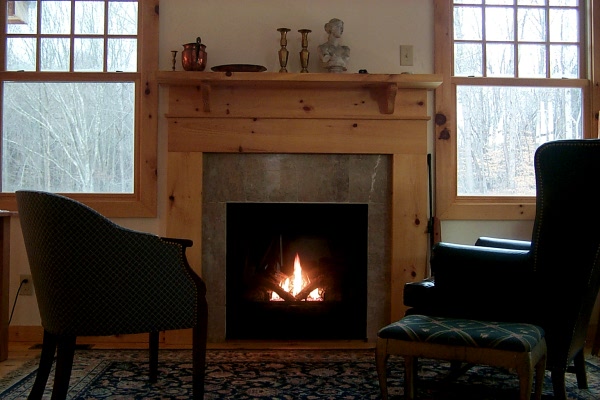
My fireplace burns propane.
While watching on DVD the 2006 Masterpiece Theater / BBC production of Charlotte Brontë’s Jane Eyre, I realized that, though some features of houses have changed a great deal over the years, fireplaces have changed very little. There was the Rumford fireplace — a more efficient fireplace — that was becoming the state of the art at the time of the American revolution. And of course coal-fired fireplaces and gas-fired fireplaces were developed. But the elemental fire and hearth are things that humans have had in their houses for as long as they’ve had houses.
Though today fireplaces have a certain utility as backup sources of heat in case our modern heating systems go down, they are not really necessary, and that is not how we justify their cost, which is considerable. We have them because we want that archetypal presence of hearth and fire in our homes. If you walk through a building supply super-store like Home Depot this time of year, you’ll even see simulated “electric fireplaces” for people who don’t have chimneys.
In Walden, Thoreau had a lot to say about the cost of our houses. He wondered why people want such big houses when much smaller houses would do, even though people sometimes spend a lifetime paying for their home. Thoreau saw this as enslaving ourselves to our houses.
If anything, houses now cost even more now than they cost in Thoreau’s day. These days, probably a third of the cost of the house goes into systems that didn’t exist in Thoreau’s day — central heating and cooling systems, electrical systems, fancy plumbing systems, and so on.
The cranky and eccentric Thoreau was quite cynical complaining about houses: “Most men appear never to have considered what a house is, and are actually though needlessly poor all their lives because they think that they must have such a one as their neighbors have.”
It was in Thoreau I encountered a reference to the Rumford fireplace: “An annual rent of from twenty-five to a hundred dollars (these are the country rates) entitles him to the benefit of the improvements of centuries, spacious apartments, clean paint and paper, Rumford fireplace, back plastering, Venetian blinds, copper pump, spring lock, a commodious cellar, and many other things. But how happens it that he who is said to enjoy these things is commonly a poor civilized man, while the savage, who has them not, is rich as a savage? If it is asserted that civilization is a real advance in the condition of man — and I think that it is, though only the wise improve their advantages — it must be shown that it has produced better dwellings without making them more costly; and the cost of a thing is the amount of what I will call life which is required to be exchanged for it, immediately or in the long run.”




